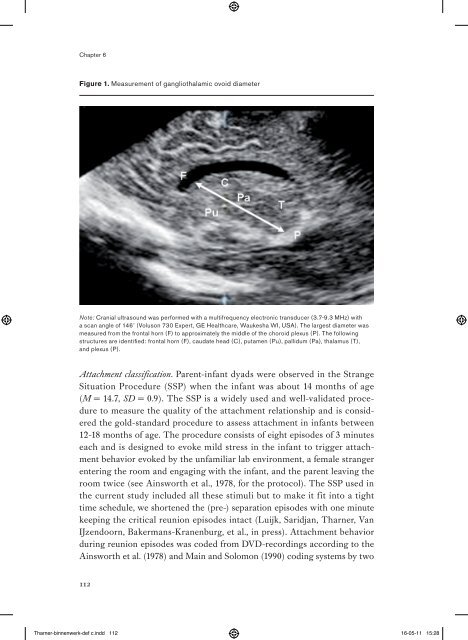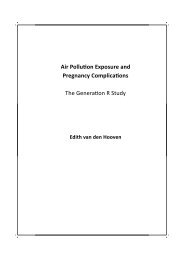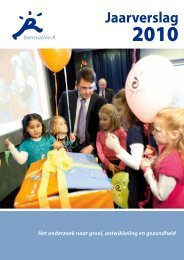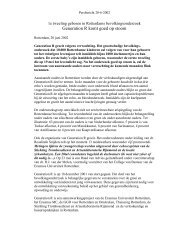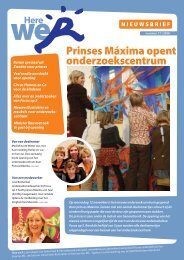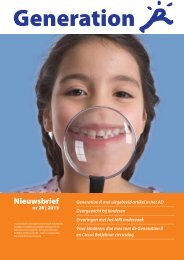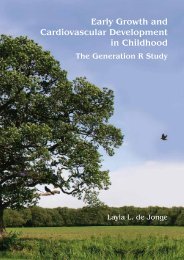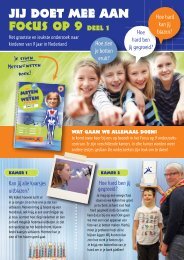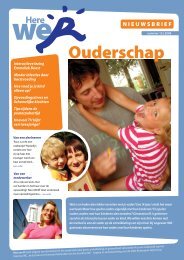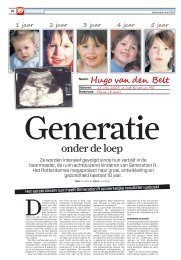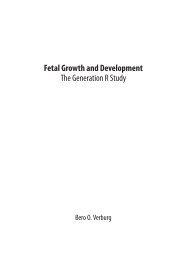Parents and infants: determinants of attachment in a ... - Generation R
Parents and infants: determinants of attachment in a ... - Generation R
Parents and infants: determinants of attachment in a ... - Generation R
You also want an ePaper? Increase the reach of your titles
YUMPU automatically turns print PDFs into web optimized ePapers that Google loves.
Chapter 6<br />
Figure 1. Measurement <strong>of</strong> gangliothalamic ovoid diameter<br />
Note: Cranial ultrasound was performed with a multifrequency electronic transducer (3.7-9.3 MHz) with<br />
a scan angle <strong>of</strong> 146˚ (Voluson 730 Expert, GE Healthcare, Waukesha WI, USA). The largest diameter was<br />
measured from the frontal horn (F) to approximately the middle <strong>of</strong> the choroid plexus (P). The follow<strong>in</strong>g<br />
structures are identified: frontal horn (F), caudate head (C), putamen (Pu), pallidum (Pa), thalamus (T),<br />
<strong>and</strong> plexus (P).<br />
Attachment classification. Parent-<strong>in</strong>fant dyads were observed <strong>in</strong> the Strange<br />
Situation Procedure (SSP) when the <strong>in</strong>fant was about 14 months <strong>of</strong> age<br />
(M = 14.7, SD = 0.9). The SSP is a widely used <strong>and</strong> well-validated procedure<br />
to measure the quality <strong>of</strong> the <strong>attachment</strong> relationship <strong>and</strong> is considered<br />
the gold-st<strong>and</strong>ard procedure to assess <strong>attachment</strong> <strong>in</strong> <strong><strong>in</strong>fants</strong> between<br />
12-18 months <strong>of</strong> age. The procedure consists <strong>of</strong> eight episodes <strong>of</strong> 3 m<strong>in</strong>utes<br />
each <strong>and</strong> is designed to evoke mild stress <strong>in</strong> the <strong>in</strong>fant to trigger <strong>attachment</strong><br />
behavior evoked by the unfamiliar lab environment, a female stranger<br />
enter<strong>in</strong>g the room <strong>and</strong> engag<strong>in</strong>g with the <strong>in</strong>fant, <strong>and</strong> the parent leav<strong>in</strong>g the<br />
room twice (see A<strong>in</strong>sworth et al., 1978, for the protocol). The SSP used <strong>in</strong><br />
the current study <strong>in</strong>cluded all these stimuli but to make it fit <strong>in</strong>to a tight<br />
time schedule, we shortened the (pre-) separation episodes with one m<strong>in</strong>ute<br />
keep<strong>in</strong>g the critical reunion episodes <strong>in</strong>tact (Luijk, Saridjan, Tharner, Van<br />
IJzendoorn, Bakermans-Kranenburg, et al., <strong>in</strong> press). Attachment behavior<br />
dur<strong>in</strong>g reunion episodes was coded from DVD-record<strong>in</strong>gs accord<strong>in</strong>g to the<br />
A<strong>in</strong>sworth et al. (1978) <strong>and</strong> Ma<strong>in</strong> <strong>and</strong> Solomon (1990) cod<strong>in</strong>g systems by two<br />
112


